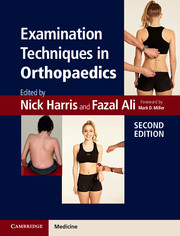Book contents
- Frontmatter
- Dedication
- Contents
- List of contributors
- Foreword
- Preface
- Acknowledgements
- 1 General principles of orthopaedic clinical examination
- 2 Examination of the shoulder
- 3 Examination of the elbow
- 4 Examination of the wrist
- 5 Examination of the hand
- 6 Examination of the peripheral nerves in the hand and upper limb
- 7 Examination of the adult spine
- 8 Examination of the hip
- 9 Examination of the knee
- 10 Examination of the foot and ankle
- 11 Examination of the brachial plexus
- 12 Orthopaedic examination techniques in children
- 13 Examination of the spine in childhood
- Index
- References
10 - Examination of the foot and ankle
- Frontmatter
- Dedication
- Contents
- List of contributors
- Foreword
- Preface
- Acknowledgements
- 1 General principles of orthopaedic clinical examination
- 2 Examination of the shoulder
- 3 Examination of the elbow
- 4 Examination of the wrist
- 5 Examination of the hand
- 6 Examination of the peripheral nerves in the hand and upper limb
- 7 Examination of the adult spine
- 8 Examination of the hip
- 9 Examination of the knee
- 10 Examination of the foot and ankle
- 11 Examination of the brachial plexus
- 12 Orthopaedic examination techniques in children
- 13 Examination of the spine in childhood
- Index
- References
Summary
History
General
Details of age, sex, occupation and problems with shoewear must always be elicited from patients with foot and ankle problems. Pain, swelling, stiffness, deformity, instability and paraesthesiae are the usual complaints. Their effects on gait, leisure and employment activities must be clearly established.
Many systemic conditions affect the foot. This is usually bilateral. A high index of suspicion must be maintained by clinicians managing foot and ankle disorders. Diabetes, rheumatoid arthritis, seronegative arthropathies, endocrinopathies, gout, pseudogout and vasculitic conditions all directly affect the foot and will influence management strategies. Swelling of the foot and ankle might reflect cardiac, hepatic and renal disease.
Unilateral swelling might be the result of secondary obstruction of the lymphatics resulting from pelvic malignancy, especially in women over the age of 50. Painless unilateral swelling of the foot or ankle may be the result of a Charcot joint in a patient with diabetic peripheral neuropathy.
Lesions of the lumbosacral spine, such as a prolapsed intervertebral disc, spina bifida and spinal stenosis, may also affect the foot, and any history of spinal abnormality must be sought.
- Type
- Chapter
- Information
- Examination Techniques in Orthopaedics , pp. 133 - 152Publisher: Cambridge University PressPrint publication year: 2014



